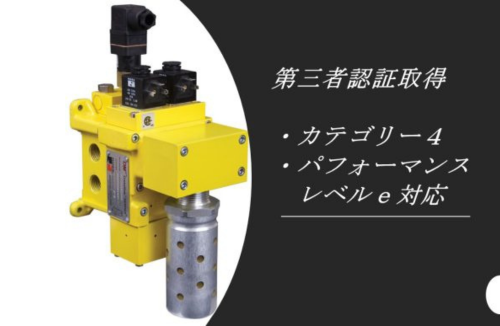Introduction ~Danger of residual air pressure~
Release residual pressure before maintenance work! Part 1
Q: What is the danger of residual pressure air?
Even if the equipment is turned off, "residual pressure air" = dangerous energy remains in the piping. When this energy is released unexpectedly , the cylinder etc. accidents can occur when people or equipment are caught .
Release residual pressure before maintenance work! Part 2
Q: When is the risk high?
Accidents tend to occur during adjustment work such as short stops, maintenance, and setup changes.
Q: How should residual pressure air be treated?
If a dedicated safety valve is used, the residual pressure air (dangerous energy) in the piping can be removed. Exhaust/ shutoff can be reliably performed. (For circuits where residual pressure exhaust is on the safe side).
In other words, for the exhaust of the power air, it is important to use reliable valves!
Five features of the DM 2® C series
- Base mount structure
- Built-in dynamic monitor/dynamic memory
- Low temperature support
- Low power consumption
- Third-party organization (DGUV) certification: Performance level PL”e”, Cat. 4 acquisition
Features ( 1 ) Base mount specifications

The DM2® series is a [valve body + piping base] specification.
It is possible to replace only the valve body while leaving the piping base .
Feature ( 2 ) Dynamic monitoring
Dynamic monitor: A monitoring method that monitors the operating status of the valve each time and enables the next operation only when safety can be confirmed. The dynamic monitor, which monitors every time, dramatically improves safety against dangerous failures.
Dynamic memory: After failure detection, the state is maintained to prevent restart. Since it can be restarted only by regular reset operation (both solenoid demagnetization / supply pressure secured / reset operation for about 1 second), prevents unexpected press start-up due to operator's procedural mistakes or skipped steps. ( dynamic memory )
(2) Internal structure and operation -1. Before startup (operation ready state)
Ready position
- Both discs are in the closed position (operation ready position).
- The air tanks (left and right) for the pilot valve are pressurized.
(2) Internal structure and operation -2. Normal operation
Normal process
Energize the solenoid coil → Air for the pilot valve passes through the pilot valve →The main piston is pushed down (both valves open), and the INside air flows into the OUTside.
(2) Internal structure and operation -3. Failure to return to one side of the valve body
Failure process
One side of the valve body fails to return → OUT side air is exhausted and the machine stops.
→ The air for the pilot valve of the “normal valve” is exhausted due to the return failure on one side.
The failure side (left side) maintains the return failure position as it is (=restart prevention state).
Since both main valves must be in the operation ready position (closed position), the operating condition of the valve is the DM2® series will not operate in the return failure state (not in the closed position = safety cannot be confirmed).
(Even if power is supplied in this state, the main piston will not open because the pilot air on the normal side is exhausted.
*The double valve does not pressurize the OUT side unless both valves are open = the machine does not move)
(2) Internal structure and operation -4. Reset operation
Valve reset process
(While supplying air to the IN side) Solenoid coil energization OFF → ①Input reset air → (2) Both pilot air is exhausted → (3) Both return pistons pressurize → Returns both main valves to the ready position (closed position).
After resetting, the air tanks for the pilot valve (left and right) are repressurized, when both discs return to the operation ready position (safety confirmation) , the valve will operate the next time power is supplied.
(2) Internal structure and operation -5. Status indicator (failure signal output function)
When asynchronous operation such as valve return failure/operation delay occurs a status indicator outputs a fault signal.
Feature ( 3 ) Low temperature support
Ambient temperature
- Conventional product: 4 to 50°C
- DM2®C Series: -10 to 50°C
Stable operation can be expected, especially in winter or at the beginning of work after vacation.
Feature (4) Low power consumption
Power consumption (each solenoid)
- Conventional product
- 50/60Hz: Starting 87VA or less / Holding 30VA or less
- DC: Starting 4W/Holding 14W
- DM2®C series
- (Size 2,4,12,30)
- 50/60Hz: 5.8W nominal, 6.5W maximum
- DC: nominal 5.8W, maximum 6.5W
- (size 8)
- 50/60Hz: Starting 36VA/holding 24.6VA or less
- DC: Start 15W/Hold 15W
- (Size 2,4,12,30)
Feature ( 5 ) Third-party organization (* DGUV ) certification
3rd party certification of DGUV Test*
- Get Performance Level PL “ e ”
- It also supports Category 4 ( Cat. 4 ) .
*German statutory accident insurance
If you have any questions about fluid machinery safety, please feel free to contact us!

